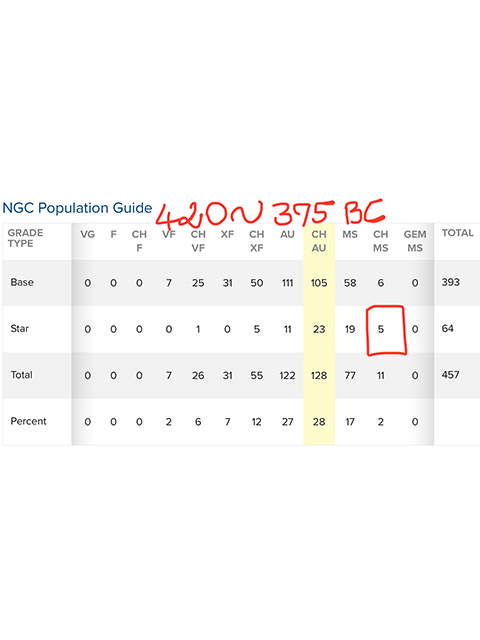「クセルクセス2世」時代金貨(又は「アルタクセルクセス2世」)!
鋳造期間:紀元前420〜385/375年
金属:ほぼ純金(96パー)金貨
鋳造地:Sardes
重量:8,35gr (スラブ合わせて50,5グラム)
直径:15ミリ
表面:英雄か王様(今だにわかっていません),槍と弓!Kidaris(冠)、Kandys(王家のローブ)。
NGC鑑定結果: CH MS 「★」 5/5、5/5 「FINE STYLE」 !!!!!
NGC鑑定番号:4372607-002
参考専門書: Carradice Type IIIb B, Sunrise 28
「Darius I 」〜「Xerxes II 」
紀元前505〜480年:GEM なし!
紀元前485年〜420年: Gem MS 1個
紀元前420年〜375年: Gem なし!
485年〜420年鑑定済みのGEM MsはNGC 4280244-002 「Star/Fine Style」もなし!!
このタイプ (紀元前420年〜375年)の最近オークション歴:
Heritage Auction Nb: 3096 (2021年3月25日) Lot 30032 « Ch Au 4/5、4/5 Fine Style » 落札結果 9000ドル。
コロナ禍以前のオークション歴で、本品と全く同じPerfect Grade、一つ前の時代の「紀元前485年〜420年」の「Ch Ms Star 5/5,5/5 Fine Style」:
Heritage Auction NB 3051 (2017年1月9日) Lot 34033
落札価格: 19,975ドル !
特記その1:本品時代ダリック金貨(紀元前420年〜375年)時代鑑定済み枚数は現在(2021年8月)「457個」に対して、一つ前の時代(紀元前485年〜420年)の鑑定済み枚数は「498個」であります。
要するに、本品時代の鑑定枚数は、全世代と比較すると、2割近く少ない!より希少性の高い最高級と言えよう。
特記その2: 本品鑑定済みはCh Ms Starは、ほかに4枚あります。ですが!。内「Star」が付いてるとは言え「Fine Style」であるのは2枚のみ。
中には、1枚の「Surface」が4/5鑑定で不完全になりますね。
もう一枚の「Ch Ms Star 5/5、5/5 Fine Style」(鑑定番号4372607-004)は、本品と同じく、以上に美しいのですが、王の冠と槍の一部がStrike上「不完全」であります。
そして13時方向にかなり目立つ鋳造上の「割れ」があります。
本品こそが! 王様/王妃に相応しき最高のDaric金貨です。
紀元前546年、「リディア王クロイソス」を破ったアケメネス朝ペルシアの「初代国王Cyrus」(キュロス2世)が、この「ダリック」金貨を作らせたのです。
Lydo-Milesian standard. Sardes, Circa 420-375 BC. Persian king or hero, wearing cidaris and candys, quiver over shoulder, in kneeling-running stance right, drapery in long curve from left knee to right ankle, right knee obscured by drapery, transverse spear in right hand, bow forward in left / Irregular rectangular incuse punch.
References: Carradice Type IIIb
The Achaemenid Persian Empire was the first long-lasting multinational state and in many ways the prototype for the Hellenistic and Roman Empires that followed.
After the conquest of the Lydian Kingdom circa 546 BC, the Achaemenids quickly adopted the Lydian concept of coinage and converted the recently invented gold stater into a new denomination, the daric, named after the Persian Great King Darius.
Darics depict a stylized image of the Great King in a martial pose, which changed in design over the following centuries.
On this issue we see him rendered in a particularly regal form, his long torso well-proportioned and elaborately draped, with a diagonal fold on his upper torso sharply defined and facial features displaying fierce determination.
